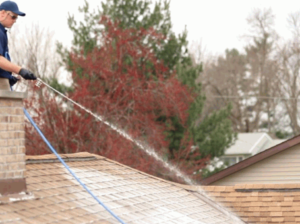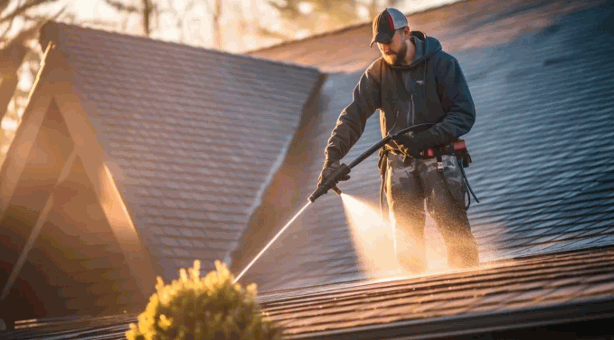Maintaining a clean roof is essential for preserving both the structural integrity and visual appeal of a home, and plays a vital role in overall roof maintenance. This article examines the concept of roof cleaning, its significance, and the various benefits associated with this practice, including algae growth prevention and moss removal. It provides guidance on the recommended cleaning frequency for roof cleaning, the different cleaning methods available, and the potential risks linked to neglecting this important maintenance task. Additionally, it offers maintenance tips for safe cleaning procedures and discusses whether this undertaking is suitable as a DIY cleaning project or should be entrusted to professional cleaners, along with a comprehensive overview of potential cleaning costs. Ultimately, readers will discover how a clean roof can contribute to the longevity and aesthetic value of their home, enhancing the overall home value.
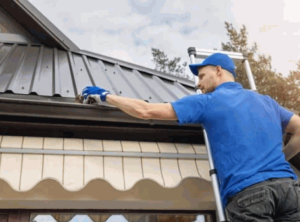
What Is Roof Cleaning?
Roof cleaning constitutes an essential maintenance task that entails the removal of debris, algae growth, moss, and other contaminants from roofing materials. This process not only improves the aesthetic appeal of a residence but also extends the roof’s lifespan, ensuring it remains in optimal condition for years to come.
Regular roof inspections are critical for identifying any signs of damage or vegetative growth that may compromise the integrity of the roofing system. Homeowners should recognize that effective cleaning methods differ based on the type of roofing materials employed, including asphalt shingles, tile, or metal roofs.
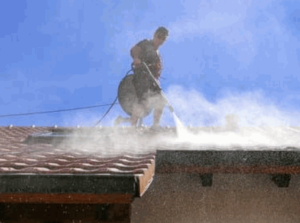
Why Is Roof Cleaning Important?
Roof cleaning is essential for maintaining the quality and longevity of roofing systems. It effectively prevents issues such as algae stains and moss growth, which can lead to considerable damage over time.
Regular cleaning plays a crucial role in the overall health of the roofing structure, minimizing the need for costly roof repairs and enhancing the protective characteristics of the roofing materials. Homeowners are advised to establish a cleaning schedule that corresponds with local climate conditions and the specific types of vegetative growth commonly found in their region, ensuring a proactive approach to roof maintenance.
Find out more: How To Stop Roof From Leaking
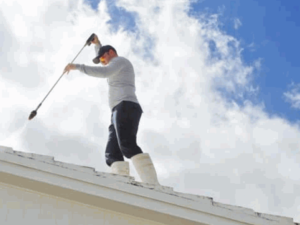
What Are The Benefits Of Roof Cleaning?
The benefits of roof cleaning extend beyond mere aesthetic enhancements; they also encompass improvements in the reflective properties of the roof, which can lead to increased energy efficiency and reduced cooling costs, contributing to substantial energy savings. Regular maintenance, whether performed by professional cleaners or through do-it-yourself methods, helps eliminate debris and prevents moisture retention that can result in issues such as mold growth and deterioration of roofing materials. A clean roof significantly enhances the overall value of the home, making it more appealing to prospective buyers.
By addressing these factors, homeowners can enjoy an extended shingle lifespan of their roofing materials, which translates to less frequent replacements and associated costs. The removal of moisture and contaminants greatly mitigates the risk of premature wear and tear on materials such as asphalt shingles and tiles.
Homeowners can also experience enhanced energy savings throughout the year, as clean surfaces reflect sunlight more effectively, thereby reducing the reliance on air conditioning during warmer months, and enhancing roof quality. Investing time in roof cleaning not only facilitates easier maintenance but also presents opportunities for significant long-term savings on repairs, including roof repairs, and utility expenses.
- Increased lifespan of roofing materials
- Improved home energy efficiency
- Enhanced curb appeal and home value
- Potential savings on repairs
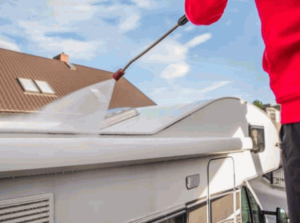
How Often Should You Clean Your Roof?
Determining the appropriate frequency for roof cleaning is contingent upon several factors, including the local climate, the type of roofing materials used, and the proximity of trees or vegetation, which can influence the cleaning process. Generally, professionals advise conducting a thorough cleaning at least once a year; however, regions characterized by heavy rainfall or significant algae growth may necessitate more frequent maintenance.
Establishing a cleaning schedule enables homeowners to proactively address potential issues and mitigate any environmental impact associated with roof cleaning practices.
Various elements significantly influence the ideal frequency for roof cleaning, including environmental impact considerations. For instance, homeowners in humid areas may experience a faster accumulation of moss and algae, which may prompt the need for semi-annual cleanings, employing effective moss treatment and algae removal techniques. Additionally, proximity to trees can lead to increased debris, such as leaves and branches, requiring more regular maintenance.
- Geographical Location: Areas with fluctuating temperatures may encounter ice damming during winter, thereby affecting maintenance requirements.
- Seasonal Changes: Spring and fall often present unique challenges, including pollen and falling leaves, which may indicate the necessity for strategic cleaning schedules.
- Environmental Considerations: The use of eco-friendly cleaning solutions can help minimize adverse effects on surrounding vegetation and wildlife.
Furthermore, homeowners are advised to conduct a roof inspection following severe weather events to ensure they remain in optimal condition, thereby prolonging the lifespan of their roofing materials.
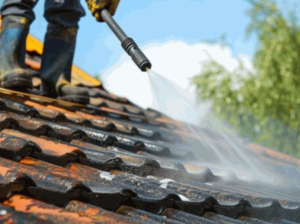
What Are The Different Methods Of Roof Cleaning?
Several cleaning methods are available for roof maintenance, each tailored to different types of roofing materials and varying levels of dirt or algae growth, ensuring an effective cleaning solution for every situation.
Soft washing is a gentle technique that employs low-pressure water in conjunction with specialized cleaning solutions to effectively remove algae and moss without causing roof damage to shingles.
Conversely, pressure washing utilizes high-pressure water to eliminate dirt and debris; however, it requires careful application to avoid harming the roofing materials, such as asphalt shingles.
Furthermore, chemical washes that utilize biocides can effectively target persistent algae and lichen, although these must be employed with appropriate cleaning precautions to safeguard the surrounding environment.
Pressure Washing
Pressure washing is a commonly employed technique for roof cleaning that utilizes high-pressure water to effectively remove dirt, debris, and moss from roofing materials, such as asphalt shingles. While this method is efficient, it is imperative to utilize the appropriate pressure settings to prevent damage to shingles or other roofing components, particularly asphalt shingles, which are susceptible to pressure damage.
This technique operates on the principle of delivering a powerful jet of water to dislodge and eliminate contaminants, resulting in both an aesthetically pleasing and functional outcome. Homeowners should recognize that the effectiveness of pressure washing may vary depending on the type of roofing material involved, highlighting the importance of understanding different roof types. For example, tile roofs tend to withstand higher pressure levels better than certain composite shingles, demonstrating the need for tailored cleaning techniques. It is essential to evaluate the roof’s condition and conduct a test of the pressure settings on a small, inconspicuous area to ensure no adverse effects occur, safeguarding the roof warranties.
Key considerations include:
- Utilizing appropriate nozzles that allow for adjustment of water flow and pressure.
- Maintaining a safe distance between the nozzle and the roof surface.
- Exploring alternative cleaning methods for more delicate materials.
Additionally, it is important to verify local regulations regarding the use of pressure washing systems, and when uncertain, consulting with roofing contractors is advisable to ensure the integrity of the roofing is preserved.
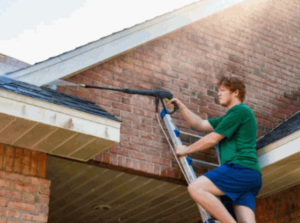
Chemical Cleaning
Chemical cleaning employs specially formulated cleaning products designed to effectively remove stubborn stains, algae, and moss from roofing surfaces, addressing various staining issues. This method typically includes the application of a biocide, which specifically targets certain types of vegetative growth, such as Gloeocapsa magma, which is commonly found on roofs, ensuring thorough algae treatment. Homeowners should always adhere to safety precautions when using chemical solutions, ensuring that surrounding plants and gutters are safeguarded against potential runoff, and considering the environmental impact.
Along with successfully eliminating unwanted growth, chemical washing provides a range of products tailored to various surfaces and specific issues. For example, professionals often select sodium hypochlorite for addressing mold and mildew, while hydrogen peroxide is preferred for its environmentally friendly attributes, reducing potential environmental impact.
When choosing a product, it is essential for homeowners to evaluate their particular cleaning needs, as the effectiveness can significantly depend on the formulation utilized. Safety considerations must remain a priority; protective gear should be worn, and detailed instructions should be followed to ensure not only the efficacy of the cleaning process but also the safety of individuals and the surrounding environment.
Types of chemical products used include:
- Sodium hypochlorite
- Hydrogen peroxide
- Detergent-based cleaners
By understanding the various solutions available and the importance of implementing safety measures, homeowners can achieve a clean and well-maintained roof without compromising their health or property, complementing homeowners insurance requirements.
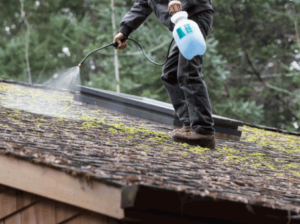
Manual Cleaning
Manual cleaning is a labor-intensive method that entails the physical removal of debris and vegetative growth from the roof using tools such as brushes or scrapers. This approach allows for meticulous cleaning; however, it necessitates the implementation of safety precautions to ensure the safety of individuals while navigating steep slopes or slippery surfaces. Homeowners are advised to seek the assistance of professional cleaners if they are uncertain about performing manual cleaning independently, or if they require debris removal and gutter cleaning services.
The significance of utilizing the appropriate equipment in this process cannot be overstated. Safety gear, including non-slip footwear, helmets, and harnesses, should always be worn to prevent accidents, ensuring roof safety during cleaning activities.
The following techniques can substantially enhance the efficiency and safety of manual roof cleaning, especially when considering DIY cleaning projects:
- Employing long-handled tools to avoid overextending oneself beyond the edge.
- Conducting work in dry weather conditions to reduce the risk of slips and falls.
- Begin the cleaning process from the top and progress downward to ensure that debris does not fall onto already cleaned areas.
By adhering to these techniques and prioritizing safety, individuals can effectively maintain their roofs while minimizing potential risks, and employ maintenance services when needed for more complex tasks.
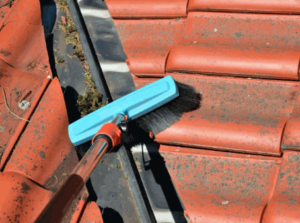
What Are The Risks Of Not Cleaning Your Roof?
Neglecting to maintain a clean roof can result in several serious risks, including considerable damage due to prolonged moisture retention and the proliferation of harmful organisms such as algae, moss, or lichen, like the commonly known Gloeocapsa magma. These conditions can undermine the structural integrity of roofing materials, leading to costly repairs or even premature replacement.
Furthermore, a dirty roof may attract pests, which can exacerbate damage and pose potential health risks for homeowners, particularly in areas like California, New York, Vermont, and Arkansas.
Damage To Roofing Materials
Damage to roofing materials represents one of the most significant risks associated with neglecting roof cleaning, as the accumulation of debris and algae, including algae spores, can trap moisture against the surface. Over time, this moisture can lead to the deterioration of materials, particularly asphalt shingles, resulting in costly repairs or replacements. Therefore, regular maintenance services are essential to prevent such issues and to help preserve the integrity of the roofing system.
Neglecting routine upkeep not only accelerates wear and tear but also diminishes the overall lifespan of the roof. For example, clay tiles may crack under the weight of accumulated debris, while metal roofs may develop rust spots due to stagnant moisture. Installing zinc strips can help prevent algae growth on these surfaces.
By employing specific cleaning methods, such as low-pressure washing or the application of eco-friendly biocides, including biocide application for targeted algae control, homeowners can effectively mitigate these risks.
Regular inspections are equally important, as they facilitate the early detection of potential issues, thereby sparing property owners from substantial future expenses.
- For asphalt shingles, utilizing a soft-bristle brush can help prevent damage during the cleaning process.
- Metal roofs require special care to avoid scratching.
- Wood shingles should be washed with a mild detergent to prevent deterioration, avoiding harsh chemicals like bleach.
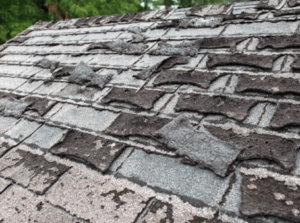
Prolonged Moisture And Mold Growth
Prolonged moisture retention on a roof can result in mold and increased algae growth, negatively impacting the aesthetic appeal of a residence and potentially posing health risks to its occupants. Mold can infiltrate the indoor environment, leading to allergic reactions and respiratory issues. It is advisable for homeowners to consult with roofing contractors or organizations such as the National Roofing Contractors Association to identify effective cleaning methods capable of addressing these issues and maintaining a healthy living space.
The health implications associated with unchecked moisture problems extend beyond superficial aesthetics and influence the air quality within one’s home. Prolonged exposure to mold can trigger various health complications, particularly in vulnerable populations such as children, the elderly, and individuals with pre-existing respiratory conditions. The presence of mold spores can lead to symptoms including, as noted by health experts from the South Coast region:
- Coughing and wheezing
- Nasal congestion
- Eye irritation
- Skin rashes
Therefore, it is imperative for homeowners to take prompt action upon observing signs of moisture retention or mold presence. Swift intervention not only preserves the structural integrity of the home but also ensures the well-being of its residents. Engaging qualified roofing contractors is essential to expertly address any underlying issues, providing solutions that prevent recurrence and thereby fostering a safer living environment.
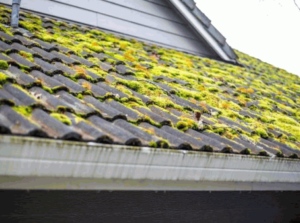
Attracting Pests And Rodents
A dirty roof can serve as a breeding ground for pests and rodents, as the accumulation of debris, algae, and plant growth creates an inviting environment for these unwelcome visitors. Infestations can result in further damage to the roof, as pests may burrow into roofing materials, potentially compromising their structural integrity and leading to costly repairs. Regular cleaning, in consultation with maintenance services, is essential to eliminate attractive vegetative growth and reduce the likelihood of pest-related issues.
Pests such as termites, ants, and mice are particularly attracted to areas that provide food and shelter. For instance, clogged gutters can retain moisture, making them appealing to these insects and rodents. Termites, specifically, thrive in damp wood, which can result in significant structural damage over time. Ants may establish nests within roofing materials, while mice can create electrical hazards by gnawing through wiring. Installing solar panels can inadvertently create additional nesting spaces for pests if not properly maintained.
- Regular roof inspections are essential for identifying and addressing these issues before they escalate.
- Makeshift solutions, such as spreading mulch, should be avoided, as they may exacerbate the problem.
- Implementing pest control measures, such as sealing entry points, can help protect a clean roof.
Ultimately, addressing potential pest habitats is crucial for maintaining the safety and longevity of the roof, ensuring that the home remains secure and free from infestations.
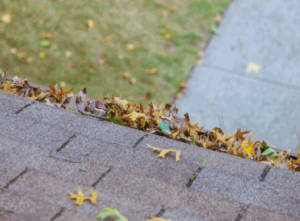
How To Safely Clean Your Roof?
Cleaning a roof safely necessitates the implementation of careful precautions to safeguard both the individual performing the cleaning and the roofing materials involved. It is imperative to wear appropriate protective gear, such as non-slip footwear and safety harnesses, particularly when working on steep slopes or utilizing ladders. Consulting with organizations like the Asphalt Roofing Manufacturers Association can provide additional guidelines on roof coating techniques to enhance safety.
Furthermore, possessing knowledge of the correct cleaning methods and products suitable for the specific type of roof is vital in order to prevent damage and preserve the integrity of the roof throughout the cleaning process. Seeking cost estimates from reputable contractors can aid in decision-making for larger projects.
Wear Protective Gear
Wearing appropriate protective gear is an essential measure to ensure safety while executing roof cleaning tasks. The essential protective equipment includes non-slip footwear, gloves, goggles, and, in certain situations, a safety harness to prevent falls. By adhering to these precautions, individuals can significantly mitigate the risk of accidents while on the roof. As safety expert Amy Freeman advises, regular inspection of gear can also enhance personal safety.
In maintaining a safe environment during roof cleaning, each piece of protective gear serves a vital function:
- Non-slip footwear: It is advisable to invest in high-quality shoes specifically designed for rooftop work, as they provide stability and grip on slippery surfaces. Ensuring that the soles are clean will maximize traction.
- Gloves: Selecting durable, abrasion-resistant gloves is important for providing a secure grip while protecting the hands from sharp debris and potentially harmful cleaning chemicals. It is essential to check for proper fit and flexibility.
- Goggles: Eye protection is crucial; one should choose goggles that fit securely and offer a clear view. This helps shield the eyes from debris and substances that could cause serious injuries.
- Safety harness: When working on steep or elevated surfaces, a safety harness can be critical. It is imperative to ensure that it is properly fitted and anchored to a secure point to reduce fall risks.
Regular inspection of protective gear prior to each task is recommended, and any worn-out items should be replaced promptly. This diligence can further enhance safety while performing cleaning tasks on the roof.
Use Appropriate Cleaning Solutions
Utilizing appropriate cleaning solutions is essential for effectively addressing stains, algae growth, and debris while preserving the integrity of roofing materials. Homeowners have the option to select between methods such as soft washing, which employs gentle solutions, or chemical washes that incorporate biocides specifically designed to target particular growths. It is imperative to understand the suitable cleaning solution for each roofing type, and consulting a maintenance service can yield tailored recommendations. For unique problems like copper staining, specific solutions are required.
When selecting a cleaning solution, it is important to consider several factors, including the specific type of roofing material, environmental conditions, and any existing warranties. For example, asphalt shingles may respond favorably to soft washing techniques that utilize milder detergents, whereas metal roofs could benefit from stronger, more targeted chemical agents. Additionally, roofing materials like those found in Vermont may require special consideration due to local climate conditions.
It is crucial to consult the following to ensure compatibility and safety with the chosen cleaning method: guidelines from the National Roofing Contractors Association and the Asphalt Roofing Manufacturers Association, which provide standardized practices for roof maintenance, including roof coating and biocide application.
- Manufacturer’s guidelines
- Maintenance service professionals
- Local regulations
By meticulously considering these factors, homeowners can preserve the integrity of their roofs while enhancing their aesthetic appeal, ultimately extending their lifespan in the process. Engaging with organizations like the Asphalt Roofing Manufacturers Association can provide additional guidance on maintaining various roofing types.
Follow Safety Precautions
Adhering to safety precautions during roof cleaning is vital to prevent injuries and damage to roofing materials. This includes the proper use of ladders, avoiding slippery surfaces, and ensuring that the cleaning process does not compromise the roof’s structural integrity. Homeowners should consider engaging professional cleaners if they are uncertain about executing the cleaning themselves. The National Roofing Contractors Association offers resources that can help homeowners find qualified professionals.
A comprehensive understanding of the cleaning process can significantly enhance safety. It is imperative to ensure that the cleaning solution used is suitable for the specific type of roofing material, as certain substances may cause harm. For example, some solutions might be formulated to specifically target Gloeocapsa magma, a type of algae that can damage roofs. Additionally, wearing appropriate protective gear, such as gloves, goggles, and non-slip footwear, can further reduce the risk of accidents.
Homeowners should always assess weather conditions prior to undertaking roof cleaning to avoid performing the task during high winds or rain, which could result in hazardous situations.
Common Mistakes to Avoid:
- Neglecting to inspect the roof beforehand for loose shingles or structural damage.
- Ignoring the necessity for a spotter when utilizing a ladder.
- Overestimating one’s abilities, particularly regarding height and balance.
Engaging professional cleaners not only ensures the application of effective cleaning techniques but also enhances safety and provides peace of mind. By entrusting this responsibility to skilled professionals, homeowners can focus on their daily activities while ensuring that their roofs receive the necessary care without the associated risks.
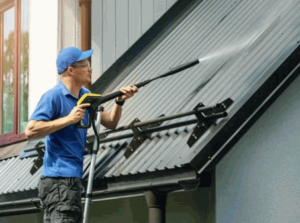
Is Roof Cleaning A DIY Project Or Should You Hire A Professional?
The decision to pursue roof cleaning as a do-it-yourself project or to engage professional cleaning services is contingent upon several factors. These factors include the type of roofing materials, the extent of cleaning required, and the homeowner’s comfort level with heights.
While undertaking a DIY cleaning approach may present a cost-effective solution, it necessitates a comprehensive understanding of appropriate cleaning techniques and safety precautions to prevent potential damage. Homeowners in states such as California, New York, Vermont, and Arkansas may find local regulations also play a role in determining the best cleaning practices. In contrast, enlisting the services of roofing contractors can guarantee a thorough and safe cleaning process, ultimately saving time and effort for the homeowner.
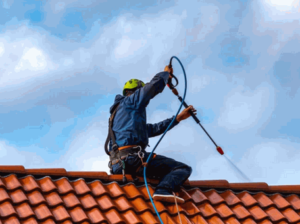
What Are The Costs Of Roof Cleaning?
The costs associated with roof cleaning can vary considerably due to several factors, including the size of the roof, the cleaning method employed, and the geographical location of the property. For instance, roof cleaning in urban areas like the South Coast may incur higher costs compared to rural areas.
On average, homeowners should anticipate expenses ranging from $200 to $800 for professional roof cleaning services. Additional costs may be incurred for any necessary extensive repairs or treatments.
A thorough understanding of the factors influencing cleaning costs can assist homeowners in making informed decisions regarding their roof maintenance.
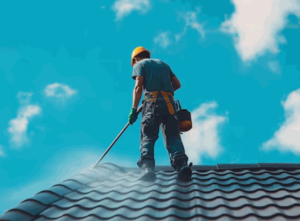
Factors That Affect Cost
Several factors can influence the cost of roof cleaning, including the chosen cleaning methods, the type of roof, and the frequency of cleaning required to maintain the materials effectively. More complex roofs, characterized by multiple slopes or significant debris accumulation, may necessitate additional labor and specialized equipment, thereby increasing overall expenses.
The local market rates substantially impact cleaning costs, as prices can vary significantly depending on the region. For example, urban areas typically experience higher labor costs compared to rural locations. Additionally, roof size plays a critical role; larger roofs require more extensive labor and materials, which can further elevate expenses. It is also important to note that different roofing materials, such as asphalt shingles, tile, or metal, each necessitate unique cleaning approaches that can affect pricing.
- Roof Size: Larger surfaces require more time and resources.
- Material Type: Each material requires specific cleaning solutions.
- Local Market Rates: Costs vary based on geographical location and competitive factors.
By evaluating these factors, homeowners can acquire a clearer understanding of the potential costs associated with roof cleaning and make informed decisions accordingly.
Average Cost Of Professional Roof Cleaning
The average cost of professional roof cleaning typically ranges from $200 to $800, depending on various factors such as the type of roof, its size, and accessibility. For example, asphalt shingles may require different cleaning solutions compared to metal roofs, which can influence pricing. Homeowners are advised to obtain cost estimates from multiple service providers to ensure competitive pricing.
Along with the type of roof, several other elements can impact the cleaning cost. The pitch of the roof can affect the level of difficulty in accessing certain areas, potentially resulting in higher labor fees. Furthermore, the extent of algae, moss, or lichen present may necessitate additional treatment steps, thereby increasing overall expenses.
- Asphalt shingles: $200 – $500
- Metal roofs: $300 – $600
- Tile roofs: $500 – $800
It is important to note that many cleaning companies offer bundled services that include roof inspections and minor repairs, which can provide added value for homeowners seeking comprehensive maintenance solutions.
Ultimately, making informed decisions based on detailed pricing can lead to significant savings and an extended lifespan for the roof.
